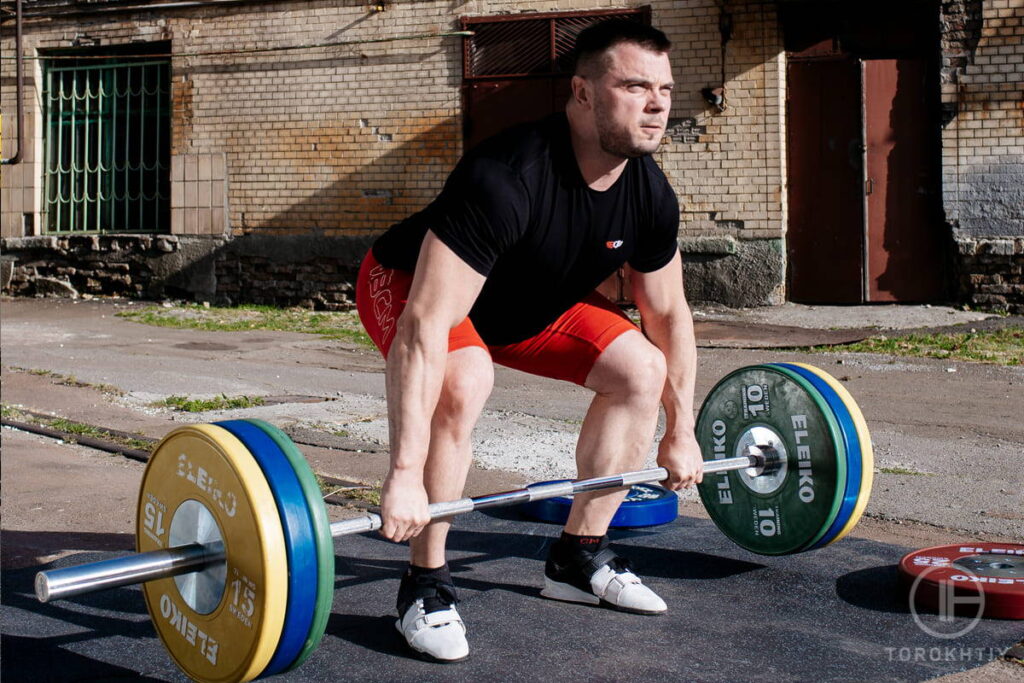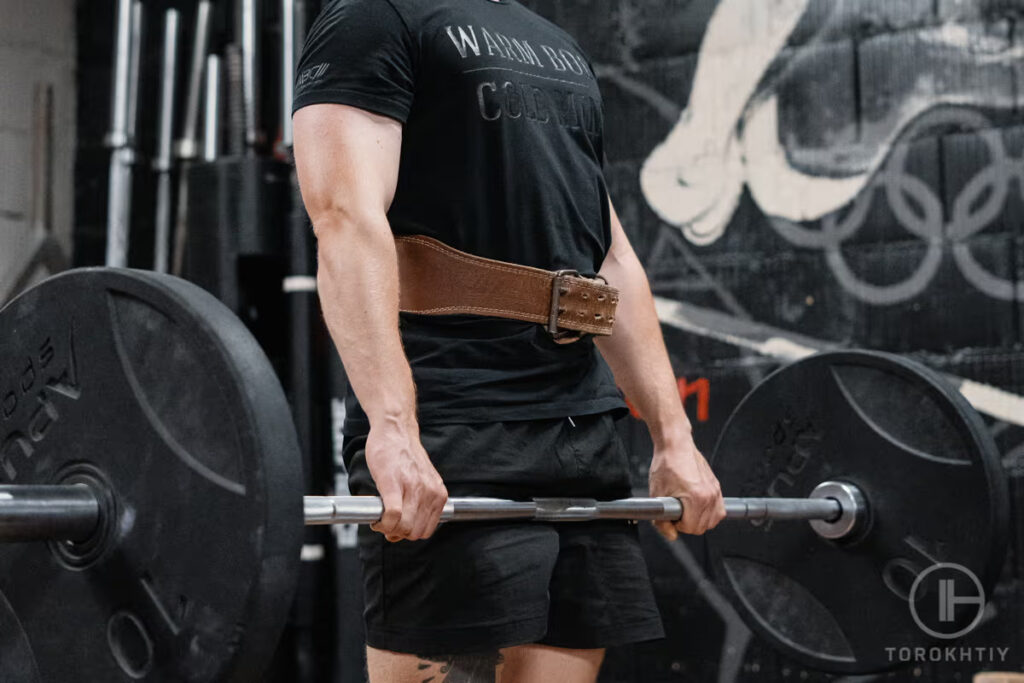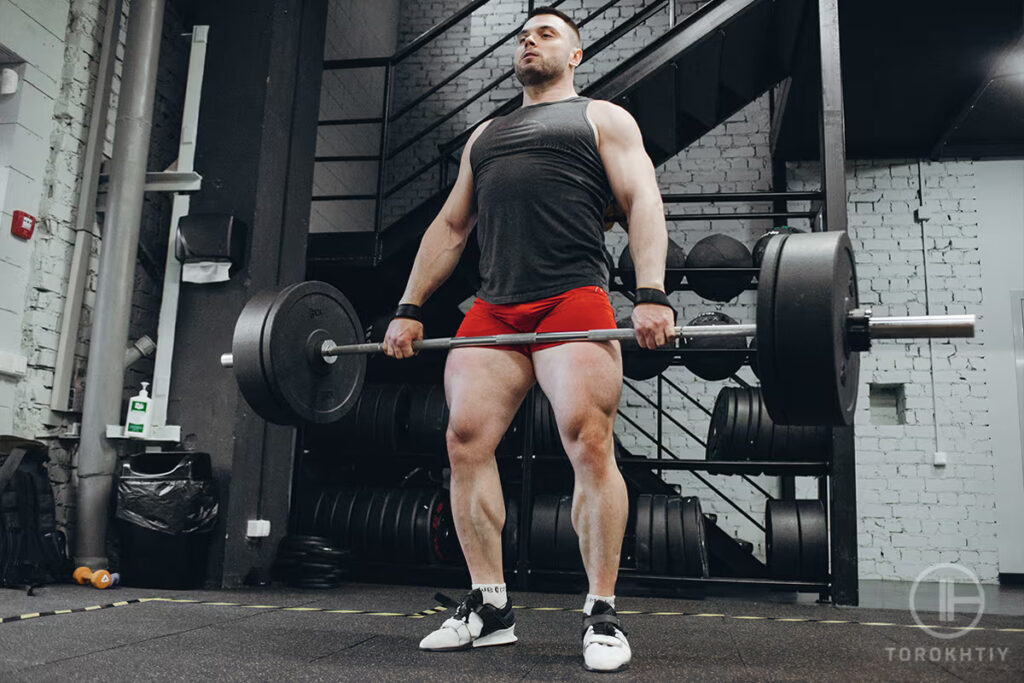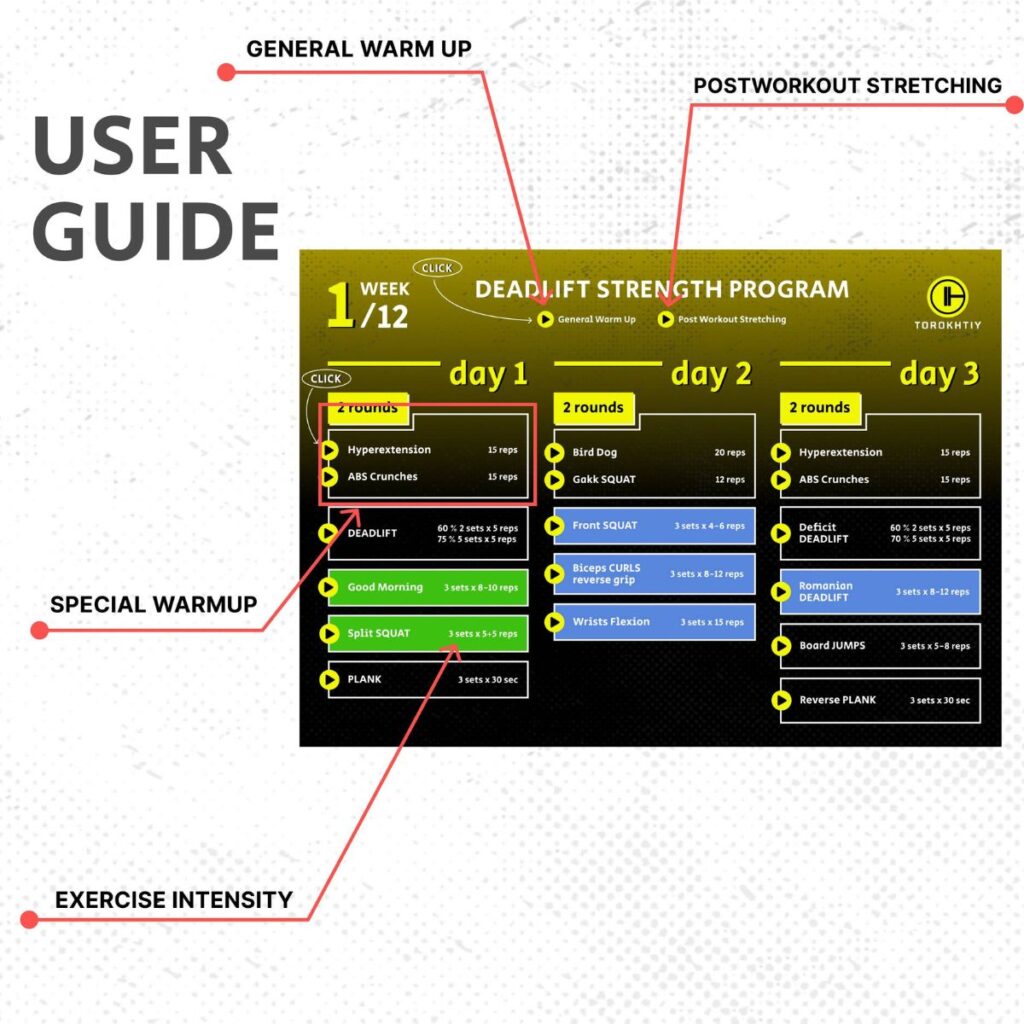Rack Pull vs Deadlift: Which Is More Effective?
Author:
Reviewed by:
(21 years of Oly Lifting experience)
Unlock your full potential by engaging with our experts and community! Have questions about your fitness journey or looking for expert advice on weightlifting techniques? Don’t hesitate — leave a comment below and Sergii Putsov will provide a personalized answer and insights to help you reach your goals.
Torokhtiy is reader-supported. Some links are affiliate links, and we may earn a commission at no extra cost to you. See our disclosure page for details.
In this article, we will answer all your questions regarding the rack pull vs deadlift debate. Deadlifts are a well-known weightlifting exercise that is praised for its ability to build overall strength and power, while rack pulls are considered an easier variation of the deadlift that still provides similar benefits. Choosing between rack pulls or deadlifts is less about which one is better and more about when it is appropriate to incorporate each exercise into your routine. Let’s dive in.
Comparing the Rack Pull vs Deadlift, there are many similarities. The primary muscle engagement is nearly the same, except the classic Deadlift is better at targeting the lower body, particularly the posterior chain, while the rack pulls AKA rack deadlift is better at developing your back.

What Are Rack Pulls?
The Rack Pull, also known as the Rack Deadlift, is a variation of the Deadlift exercise with the main difference being the starting position. While a classic Deadlift starts and ends with the barbell placed on the ground, the deadlift Rack Pull places the barbell on an elevated surface, such as a pair of safety arms or weightlifting blocks.
By starting from a higher position, the rack pull allows the lifter to start at knee height or slightly above. This eliminates the initial portion of the deadlift and results in a shorter range of motion (ROM) that requires less power from the lower body while emphasizing the upper portion of the lift, also known as the “lockout”.
As a result, the exercise becomes more efficient for the back muscles, including the erector spinae, lats, traps, and rhomboids, while still providing a good workout for the glutes, hamstrings, and forearms. Many people compare the rack pull vs Romanian deadlift variations due to similar ROM. However, the slight difference is that Romanian deadlifts are a continuous exercise, while a deadlift rack pull has a platform for rest and reset.
Benefits Of Rack Pulls
✔️ Excellent Back Development
By focusing on the lockout portion of the deadlift, rack pulls serve as an excellent compound exercise for developing the back. They allow you to train the upper and middle back, including muscles such as the latissimus dorsi (lats), trapezius (traps), rhomboids, and erector spinae at the same time. This makes the exercise highly effective while also being relatively simple to perform.
✔️ Complimentary To Deadlifts
Studies have shown that Rack pulls can be a great complementary exercise for improving deadlift performance, especially if you struggle with the lockout portion. They target similar muscle groups, but with a shorter range of motion and less stress on the lower back and posterior chain.

This makes rack pulls an excellent option for athletes who are recovering from an injury or experiencing muscle fatigue in those areas while still wanting to build strength in the upper back and related muscle groups.
Disadvantages Of Rack Pull
❌ Requires More Equipment
To start Deadlifting, all you really need is a barbell and a set of weight plates. However, performing rack pulls safely requires a rack with safety arms, weightlifting blocks, or another elevated surface. This means you will either need to spend more money on equipment or find a creative DIY solution, which may not be as safe and effective.
❌ Limited Carryover
The classic deadlift is a widely used exercise popular in various types of training due to both strength and functional benefits. In contrast, rack pulls are a specialized exercise that offers limited carryover to other exercises, sports, or everyday activities compared to the deadlift. Unless your specific goal is performing a compound back exercise, rack pulls may be challenging to incorporate into a workout, other than as a complementary or substitute exercise for the deadlift.
How To Do Rack Pulls
Here’s how to properly do a Rack Pull, as well as which mistakes to avoid:
- Start by setting the barbell on the safety pins or blocks so that it rests at knee height or slightly above
- Stand with your feet shoulder-width apart and the bar centered over your feet.
- Keep your toes pointing slightly outward and your shins close to the bar.
- Bend down with a straight back, hinge at the hips, and grab the bar with your hands shoulder-width apart.
- Keep your shoulders pulled back and down and your arms straight.
- Maintain a straight spine, keep your chest up, and shoulders back to avoid arching your back.
- Keep your head neutral and look forward or slightly upward.
- Take a deep breath into your diaphragm (stomach) and tighten your core before starting the lift.
- Keep your feet firmly planted, push through your heels, and lift the bar off the safety pins by extending your hips, flexing your legs, and raising your chest.
- Remember, don’t use your arms for added strength, and make sure the bar moves in a strictly upwards trajectory and stays close to your body.
- Be sure to avoid jerking the weight up or rounding your back.
- Once the bar has cleared the safety pins, stand up straight with your chest up, shoulders pulled back, and hips fully extended.
- Exhale and lower the bar following the same movement pattern in reverse.
- Remember to keep your body straight and core tight, and avoid lifting with your arms or rounding your back.
- Control the bar during descent and try not to drop it unless required due to outside factors.
What Are Deadlifts?
Deadlifts are a compound exercise popular in various forms of training for being both strengthening and functional. When done with proper form and technique, it activates your hamstrings, glutes, spinal erectors, lats, traps, forearms, and abdominals, making it a near full-body exercise. The Deadlift is also one of the three official competitive Powerlifting exercises, along with the Squat and Bench Press.
The deadlift is often explained as a three-part exercise consisting of the setup, pull, and lockout phases. First, during the setup, the athlete ensures they are standing in the proper position, grips the barbell, and takes a deep breath into the diaphragm to brace themselves.
To begin the pull, they then forcefully extend the hips and knees while keeping a straight back and tight core. Finally, in the lockout portion, the athlete stands upright, locking their hips and knees into extension, still maintaining a straight back and tight core. Finally, the barbell is lowered to the ground in a controlled motion.
Benefits Of Deadlifts
✔️ Near Full-Body Exercise
The deadlift is a compound exercise that, when done correctly, activates a large number of muscle groups to create a near full-body exercise. Deadlifts engage your glutes, hamstrings, quadriceps, lower back, upper back, traps, forearms, and more all at the same time.
This makes them not only highly engaging and efficient for strength development, but the performed motion trains your core, stability, posture, grip, endurance, etc.
✔️ Quality Of Life Improvement
The deadlift is a compound exercise that engages multiple muscle groups and places weight-bearing stress on the entire body. In addition to strengthening the muscles of the lower body, back, and core, deadlifts can also increase bone density, boost metabolism, burn calories, and improve endurance.

These benefits not only contribute to physical fitness, but also lead to a better quality of life, particularly in older adults. Regular deadlifting can help reduce the risk of common age-related issues, such as bone fractures, cardiovascular disease, back pain, and cognitive decline.
Disadvantages of Deadlift
❌ Exercise Difficulty
Deadlifts are a highly complex exercise that requires proper form and technique to execute safely and effectively. They can’t be picked up on a whim and it may take a few practice sessions before you can incorporate them into your workout. Overall, this makes it a highly difficult exercise with plenty of risks involved if rushed through or underestimated.
❌ High Risk Of Injury
Closely tied to the point of exercise difficulty, deadlifts carry a high risk of injury due to the sheer amount of muscle engagement and simultaneous movement occurring at once. Even when mastered, there’s still plenty of potential to get hurt during deadlifts. In fact, out of the three powerlifting exercises, deadlifts have the highest percentage of recorded injury.
Moreover, injuries that occur during deadlifts often target highly sensitive areas, such as the lower back and joints, which can result in significant downtime from exercise and may require serious rehabilitation methods, including surgery.
Follow us!

Free!
Get a 2-week Weightlifting Program as a bonus for the subscription to kickstart your training plan!

Free!
How To Do Deadlifts
Here’s a step-by-step guide on Deadlifts, along with some tips and mistakes to avoid:
- Begin by standing with your feet shoulder-width apart, and the barbell on the floor in front of you.
- Make sure the bar is centered over your feet, and your shins are close to the bar.
- Bend down with a straight back, hinge at the hips, and grasp the bar with your hands shoulder-width apart.
- Keep your shoulders pulled back and down and your arms straight.
- Maintain a straight spine, keep your chest up, and shoulders back to avoid rounding your back.
- Keep your head neutral and look forward or slightly upward, avoid looking straight down as it can lead to loss of balance.
- Take a deep breath into your diaphragm (stomach) and tighten your core before lifting.
- Keep your feet firmly planted, push through your heels, and lift the bar off the ground by extending your hips, flexing your legs, and raising your chest.
- Your hips and shoulders should rise simultaneously as you lift, and avoid using your arms for added strength.
- The bar should move in a strictly upwards trajectory and stay close to your body, even scraping your shins on its way up and down.
- Avoid jerking the weight up or rounding your back.
- Once the bar has cleared your knee height, stand up straight with your chest up, shoulders pulled back, and hips fully extended.
- Exhale and lower the bar following the same movement pattern in reverse.
- Keep your body straight and core tight and avoid lifting with your arms or rounding your back.
- Control the bar during descent and avoid dropping it unless required due to outside factors.
- Remember not to rush through the exercise.
Rack Pull VS Deadlift: What’s The Difference?
Range Of Motion
The main noticeable difference between the rack pull vs deadlift is in the exercise range of motion (ROM). Rack pulls have a shorter ROM than most deadlift variations. This is because the bar starts from an elevated position, placed on safety arms or a pair of weightlifting blocks, unlike the deadlift where you lift the bar from the ground up.
Muscle Groups Used
Overall, the muscle groups engaged in the deadlift vs rack pull are nearly identical, but the intensity at which they work differs. However, based on each exercise’s range of motion, it could be said that rack pulls are primarily an upper-body exercise with most focus placed on the upper back, with a slight emphasis on the posterior chain, while the opposite stands true for deadlifts.
The overlapping muscle groups include:
Weight Capacity
Most people will experience a difference in rack pull VS deadlift weight capacity. Due to the shorter range of motion and elevated starting position, lifters experience less gravitational force during a rack pull.

Furthermore, the shorter ROM leads to sooner and stronger engagement of the upper back, which plays a major role in lifting and balancing the weight. This means that, on average, most people can lift higher weight capacity from the rack barbell rack pull vs deadlift.
FAQ
Can Rack Pulls Replace Deadlifts?
Although Rack Pulls are a Deadlift variation, they omit a critical component of the classic Deadlift exercise. Specifically, they exclude the initial pull phase, which can limit lower body development. As a result, Rack Pulls are not considered an adequate replacement for Deadlifts, but rather a useful complementary exercise and an excellent compound exercise for back training. That said, depending on your exercise goals, alternating between Rack Pulls and Deadlifts can be effective.
How Often Should You Do Rack Pulls Or Deadlifts?
For beginner athletes, it is recommended to limit rack pull or deadlift sessions to one or two per week, with a minimum of two rest days in between. Advanced athletes may choose to include both exercises every other day, but it is still important to have at least one day of rest in between sessions, and an additional day of rest after every third training session. Both rack pulls and deadlifts are physically and mentally demanding exercises, and the more frequently they are performed, the higher the risk of fatigue and injury.
Are Rack Pulls Harder Than Deadlifts?
Rack pulls are often seen as an easier option compared to deadlifts, as they require a shorter range of motion and put less pressure on the posterior chain. However, this can vary depending on the individual strengths and weaknesses of the athlete. Those with greater lower body strength and explosiveness may find the momentum from the lift phase crucial for completing the exercise. Conversely, individuals with more upper body strength may struggle during the lift phase, especially if they have a weaker posterior chain, but find the lockout phase relatively easy.
Conclusion
As you’ve seen, there is plenty of exercise overlap between the rack pull vs deadlift. Choosing between rack pulls or deadlifts comes down to your exercise goal for the day, as both are highly beneficial compound exercises with similar benefits.
Although there is plenty of overlap in muscle groups engaged, the traditional deadlift is more effective in training the lower body, specifically the posterior chain, while the Rack deadlift is better suited for developing the middle and upper back.
Are deadlifts a part of your regular workout routine? If so, have you also tried rack pulls as an alternative? Leave a comment to let us know and don’t forget to follow our social media pages where we share lots of valuable fitness content.
Also read:
- Deadlift Stances
- Good vs Bad Deadlift Form
- Why Is Sumo Deadlift Easier
- Functional Fitness Deadlift Workouts
- Deadlifts vs Good Mornings
- What Muscles Does Sumo Deadlift Work
- Deadlift Grip
- Are Deadlifts Good for Lower Back
- Average Deadlift
- Deadlift Program
References:
- Hamstrings // PhysioPedia: https://www.physio-pedia.com/Hamstrings
- Strength training can help protect the brain from degeneration // Sydney: https://www.sydney.edu.au/news-opinion/news/2020/02/11/strength-training-can-help-protect-the-brain-from-degeneration.html
- Changes in bone mineral density in response to 24 weeks of resistance training in college-age men and women // NCBI: https://pubmed.ncbi.nlm.nih.gov/20647940/
- Kinematics and kinetics of the dead lift in adolescent power lifters // Journals: https://journals.lww.com/acsm-msse/Abstract/1985/10000/Kinematics_and_kinetics_of_the_dead_lift_in.8.aspx
- Powerlifting // Wikipedia: https://en.wikipedia.org/wiki/Powerlifting
- The Relationship Between Partial and Full Range of Motion Deadlift 1-Repetition Maximum // NCBI: https://pubmed.ncbi.nlm.nih.gov/36730557/
Why Trust Us?
With over 20 years in Olympic weightlifting, strength training, nutrition coaching, and general fitness our team does its best to provide the audience with ultimate support and meet the needs and requirements of advanced athletes and professional lifters, as well as people who strive to open new opportunities and develop their physical capabilities with us.
By trusting the recommendations of our certified experts in coaching, nutrition, and sports training programming, as well as scientific consultants, and physiotherapists, we provide you with thorough, well-considered, and scientifically proven content. All the information given in the articles concerning workout programming, separate exercises, and athletic performance, in general, is based on verified data.
The product testing process is described in more detail here.
Author: Sergii Putsov
Head of Sport Science, PhD
Best Results: Snatch – 165 kg,
C&J – 200 kg
Sergii Putsov, Ph.D., is a former professional weightlifter and National team member, achieving multiple medals in the 94 kg weight category at national competitions. With a Master’s degree in “Olympic & Professional Sport Training” and a Sport Science Ph.D. from the International Olympic Academy, Greece, Sergii now leads as the Head of Sport Science. He specializes in designing training programs, writing insightful blog articles, providing live commentary at international weightlifting events, and conducting educational seminars worldwide alongside Olympic weightlifting expert Oleksiy Torokhtiy.
Reviewed by: Oleksiy Torokhtiy
Olympic Weightlifting Champion, PhD in Sport Science
Best Results: Snatch – 200 kg,
C&J – 240 kg
Oleksiy Torokhtiy is a professional athlete boasting 20 years of experience in Olympic weightlifting. With multiple European and World titles under his belt, he has showcased his prowess in two Olympic Games (Beijing 2008 and London 2012). Upon concluding his illustrious career, Oleksiy dedicated himself to coaching. By 2022, he had conducted over 200 weightlifting seminars worldwide. He is the visionary behind an international sportswear and accessories brand known for its motto, “Warm Body Cold Mind.” Additionally, he is an esteemed author and the creator of a series of training programs and eBooks.





Still have questions after reading our article? Unlock your full potential by engaging with our experts and community! Don’t hesitate — leave a comment below and Sergii Putsov will provide a personalized answer and insights to help you reach your goals.